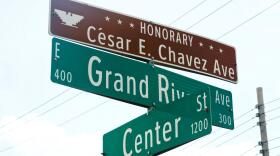For the next few days, WKAR reporters are sharing how technology built or tested here in Michigan may change our lives. But some of the most useful technology for modern day communication is over a century old. WKAR's Karel Vega visited a dedicated group on Michigan State University’s campus devoted to ham radio.
Tucked away on the second floor of Michigan State University’s College of Engineering Building is the MSU Amateur Radio Club.
In a narrow room lined with electronics, a small group of enthusiasts keep a century old hobby alive.
Out of the static a faint voice emerges. A huge appeal in the world of amateur, or ham radio is making contact with people from all over the world.
But what exactly is amateur radio? How does it work? And what separates it from the radio you hear in places like your car?
Reece Cole, 22, is the president of MSU’s amateur radio club, And a senior at MSU.
“The biggest difference between conventional AM-FM radio and amateur radio is actually a legal one." Says Cole. "AM-FM radio is used for commercial public broadcasting while amateur radio is used for non-commercial person to person and machine to machine communication.”
By the way, Ham radio, which is the term most people use for amateur radio, isn’t actually an acronym like most people think.
According to the American Radio Relay League, the story goes that back in the times before federal regulation required radio operators to work on separate bands government, commercial, and amateur operators all communicated on the same spectrum. Frustrated by the interference, commercial operators started referring to the amateurs as “hams” and the phrase stuck.
Now, the FCC allots different parts of the radio spectrum for different uses. And with amateur radio, there are many ways to communicate.
“The other major difference is that amateur radio can transmit data images, voice, text." Says Cole. "Basically any type of communication you can send over the internet, over a computer you can send over amateur radio. Whereas AM and FM can only transmit audio and voice.”
In fact, the same method used by astronauts decades ago to send images of The Moon back to Earth are still used by radio enthusiasts today. Take a listen at the file below.

What you’re hearing right now is a form of communication called slow-scan television. This noise is actually a picture of MSU’s amateur radio club. One popular activity with amateur radio enthusiasts is sending these slow scan images to other people around the world.
This is just one of many different ways that amateur radio enthusiasts communicate. In the corner of the room, Vice President Teng Xu is speaking with someone in France using Morse code.
On a separate screen, words start to emerge identifying the person we’re communicating with four thousand miles away.
Because this technology is so reliable, during times of crisis, like natural disasters, operators can use their knowledge and technology to aid in relief efforts. In the Aftermath of Hurricane Maria, the MSU Amateur Radio Club served as a point of communication for people in Puerto Rico.
“We’ve helped pass messages between the island and the mainland and we’ve been in communication with the observatory there including a person there who’s actually originally from Michigan State." Cole explains. "And if there’s messages they have for us that they want us to give to somebody else we do that or if there’s messages that someone wants us to give them we do that as well.”
The MSU Amateur Radio club is a constant work in progress. Ed Oxer, 75, has been associated with the club since the early 70’s when he was a grad student at MSU.
“The club is evolving. Says Oxer. "We think we have a wonderful set of resources here and we are supported by the electrical and computer engineering department of the college of engineering. The Dean of the college of engineering is in fact a licensed amateur radio operator, he's very supportive.”
Amateur radio lives on thanks to its dedicated community world-wide.
“Really just kind of going back to why there’s such an international appeal, it’s because it connects everybody from everywhere." Says Cole. "There’s just this huge element of friendship and just international community and just kind of fostering prosperity through cooperation I think.
The MSU amateur radio club will celebrate its hundredth anniversary in 2019.
-----
Correction November 15 ,2017 - 7:45 pm
An earlier version of this story referred to the American Radio Relay League as The National Association For Amateur Radio. "The National Association For Amateur Radio" is actually their tag line.








